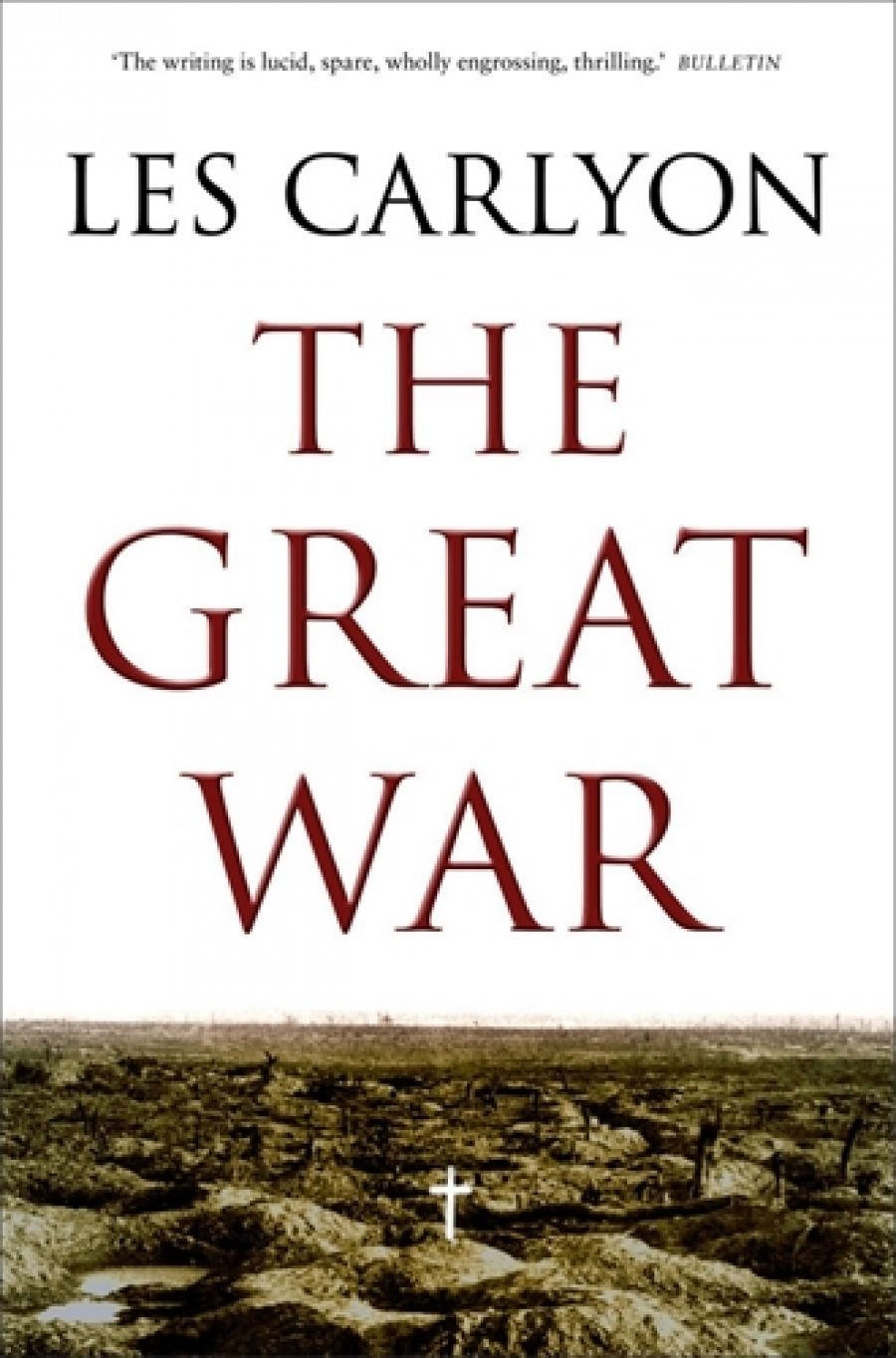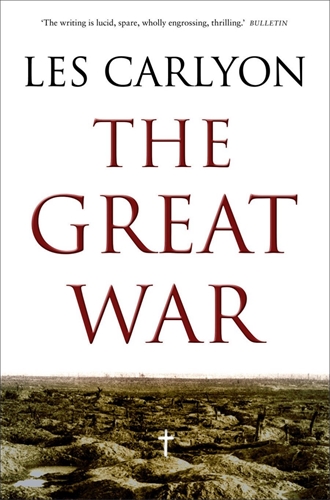
- Free Article: No
- Contents Category: War
- Custom Article Title: So many never seen
- Review Article: Yes
- Article Title: So many never seen
- Online Only: No
- Custom Highlight Text:
After the phenomenal success of his Gallipoli (2001), Les Carlyon has turned his attention to the experience of Australian soldiers on the western front in the years 1916–18. Carlyon’s purpose in The Great War is clear: he wants to expand the national gaze that is transfixed on the military exploits at Anzac Cove, to include the lesser-known stories of the Australian Imperial Force (AIF) in France and Flanders. Five times as many Australians perished in the war’s main European theatre as had died fighting at Anzac Cove, but those post-Gallipoli soldiers tend to be accorded a second-rung status in the nation’s memory of the war. As Carlyon says: ‘There were so many, and they were ours, and we never really saw them.’
- Book 1 Title: The Great War
- Book 1 Biblio: Macmillan, $55 hb, 863 pp, 140503761X
- Book 1 Cover Small (400 x 600):

- Book 1 Cover (800 x 1200):

The Great War opens at Fromelles, the first battle the Australians faced in France. Fromelles is a name that ‘refuses to lodge in the Australian consciousness’ – perhaps with this book it might just begin to do that. Carlyon gives a dense account, followed by a similar treatment of the other major Australian battle of 1916, Pozières. Then it’s on to the bitter cold of winter in the trenches, relieved only by the misery of Passchendaele in 1917.
Surprisingly perhaps, the victories of 1918 are treated lightly. Carlyon wisely avoids the hairy-chested claims about how ‘Australia won the war’; neither is he jingoistic about the merits of Australian troops. Certainly, the AIF volunteers had superior skills and morale to the British Tommies of 1918, but if Australia had drawn on conscripts to the extent that other combatant nations did, there is no question that the fighting quality of the forces would have deteriorated accordingly. In fact, in Carlyon’s view, ‘there were no better troops on the western front than the New Zealanders’. A magnanimous declaration – though perhaps the Germans might have a valid claim here, too.
A curious omission is that there is no analysis of repatriation. It is as if when the war ended, all the boys simply caught the next train home, when in fact it was a year before the last troops reached Australia. It seems that, by the time the armistice arrives, Carlyon is as keen to end his book as the troops were to get home.
As in Gallipoli, this book is testament to the author’s skill as a writer. Carlyon has a journalist’s eye for distilling the essence of a scene, and an engaging way with pen portraits of the major players. He also shows his gift for clear, epigrammatic description. You can immediately appreciate the nuances in the lie of the land when Carlyon tells us, ‘The Somme says eels and the Ancre says trout’. Carlyon neatly encapsulates Bean’s flaw as an historian in the observation that, ‘he tended to write like a solicitor, loading up sentences with caveats and parentheses’. But whereas in Gallipoli Carlyon kept the pace snappy and the focus tight, the same cannot be said here. The western front is a lot larger than Anzac Cove, and the scale of forces and material dwarfs that of the Gallipoli campaign. Moreover, as one turns the pages, the book’s purpose and direction appear to get confused, and there is a growing sense that Carlyon is being defeated by the weight and scope of his chosen subject.
The problem is apparent in the very title: The Great War. This ambitious label gives the impression of a comprehensive account such as John Keegan’s The First World War (1999), yet this is misleading. Carlyon skips the first years of the war, and simply drops the reader in the mud of the Somme in July 1916 with little context. He largely ignores any battle that doesn’t involve Australians, and even stays clear of the Middle East, where the Australian Light Horse achieved such fame. A subtitle of ‘Australians on the western front’ might have been appropriate. But even that would be inaccurate, because Carlyon frequently leaves the individual soldier in the trenches to muse about more interesting characters making a splash on the international scene.
There is Billy Hughes of course, ranting and raving and making every use of the ambitious pressman Keith Murdoch. There’s British prime minister David Lloyd George, vainly trying to restrain his military commanders from spending the nation’s youth in a war of attrition. We watch the French general Robert Nivelle digging his own grave with extravagant promises and misguided tactics, and follow Vladimir Lenin, dashing back from exile in Switzerland to make his dramatic appearance at Petrograd’s Finland Station. Most of all, though, Carlyon’s gaze falls on Field Marshal Sir Douglas Haig, aloof and alone, yet holding his nerve while many around him didn’t. Haig in fact emerges from the pages as the most comprehensively drawn character, and the analysis of this most controversial figure is, if not sympathetic, then at least balanced. Haig is of course the dominant figure on the British side from 1916, yet Carlyon’s decision to fill in the wider military strategy and political intrigues inevitably takes the focus away from the individual Australian soldier.
The book nevertheless benefits from extensive research. Carlyon’s understanding of tactics on the western front is clearly informed by the work of Robin Prior and Trevor Wilson, and his descriptions of individual battles makes frequent reference to Bean’s comprehensive Official History. He is also prepared to take issue with Bean, agreeing with Eric Andrews’s criticisms of the Official History’s account of Second Bullecourt.
Carlyon’s engagement with much recent academic history on the war is rather patchy, however. When he complains that little attention has been given to postwar grieving and trauma, he shows an ignorance of the important work of both Stephen Garton and Joy Damousi. Nor is there any mention of Dale Blair’s meticulous Dinkum Diggers (2001), which gives a much more complex and comprehensive picture of the Australian infantryman than Carlyon achieves. It also seems something of a shortcoming that there is no acknowledgment of the work of Patsy Adam-Smith, whose enormously popular book The Anzacs (1978) did so much to make sure that the Australian people did know the stories of the men that Carlyon complains ‘we never really saw’.
Finishing this book feels like something of a pyrrhic victory. It offers the general reader an engaging account of various aspects of the war from an Australian perspective; but it lacks the comprehensive detail of military history; the political anecdotes are already familiar; and it’s only the top brass and the Victoria Cross winners (hardly forgotten heroes) who stand out in the narrative. The scale defeats Carlyon, together with an unresolved tension between content and form. Ultimately, the book is stranded in no man’s land between the trenches on one side, and the staff tent and political salons on the other, not knowing which way to look.


Comments powered by CComment